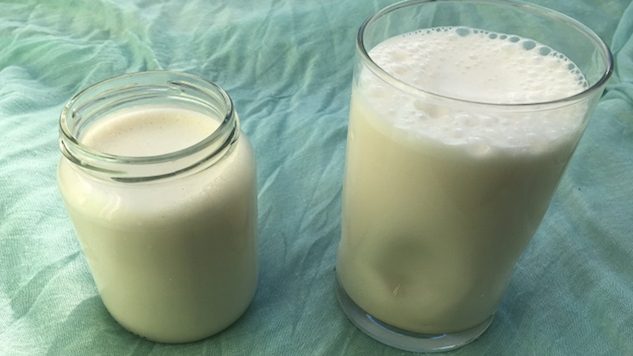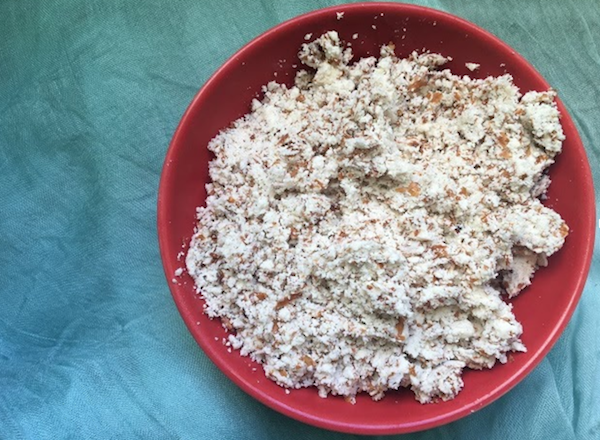Why Almond Milk is So Controversial
And Why You Should Just Make Your Own
Photos by Annie Bacher Food Features Almond Milk
As much as it might surprise hipster millennials of 2017, (myself included), almond milk existed long before almond lattes became a regular item on café menus.
Almond milk grew 250 percent in popularity from 2012 to 2015, according to data from the Nielsen company, but it was used hundreds of years before the days of Instagrammed smoothie bowls. In fact, the history of almond milk goes back hundreds of years.
According to authors of History of Soymilk and Other Non-Dairy Milks (1236-2013) William Shurtleff and Akiko Aoyagi, it was first mentioned in writing in a 13th-century cookbook in Iraq, which describes the process of creating the alternative milk. And according to historians, Europeans also used almond milk as a special substitute for animal milk during Lent as early as the 13th century.
Fast forward to 2017, and almond milk has gone mainstream. Many, including Shurtleff and Aoyagi, attribute the recent success of almond milk to growing concerns about growth hormones in dairy milk, and to the preference for the taste of almond milk. It’s also lower in calories than dairy milk, and has no cholesterol.
Almond Milk Isn’t Always So Innocent
It’s easy to label almond milk as an angelic substitute for dairy milk. But not so fast.
Seemingly innocent almond milk has been embroiled in a significant amount of controversy of its own. Mother Jones writer Tom Philpott started an almond milk firestorm with his article titled “Lay off the Almond Milk, You Ignorant Hipsters.” He points out that a typical 48-ounce bottle of almond milk contains a negligible amount of protein—about as much as a handful of almonds. Many of the nutrients, including Vitamin E and Calcium, boasted by almond milk labels come from additives, and not from the goodness of almonds themselves.
Philpott provides plenty of subjective arguments as well: “I think it’s deeply weird to pulverize their crunch, drown them in water and send them out to the world in a gazillion little cartons.”
Claims beyond the “weirdness” of producing milk with almonds include environmental concerns. It takes 23 gallons of water to produce a single gallon of almond milk. And when 80 percent of the world’s almonds are produced in drought-ravaged California, there’s cause for consternation. But on the other hand, it turns out a single gallon of dairy milk requires 30 gallons of water, due to the water required to grow cows’ food. So almond milk is still the more environmentally friendly of the two.
For those on Team Almond Milk, there are a growing number of brands to choose from. But as an increasing number of brands pop up in supermarkets and specialty grocers alike, there is a wide variation of quality, use of additives, texture and almond content.
A perfect example of this quality disparity is the great almond scandal of 2015. Popular almond milk brands Blue Diamond Almond Breeze and Silk were faced with a lawsuit claiming that they misled consumers about the quantity of almonds in their product, although it contains only 2 percent almonds. Business Insider compared almond milk to “a glass of water and a multivitamin,” referring to the wide use of supplemental potassium, vitamin A and vitamin D added to almond milk.
Other common additives include carrageenan (a thickener), sugar, locust bean gum, sunflower lecithin, gellan gum, evaporated cane juice (sugar), pea protein, rice protein and guar gum. Whew. When you start to study the lengthy ingredient lists of popular almond milk brands, making your own becomes even more appealing.
The Case for Making Your Own Almond Milk
Luckily, the DIY almond milk method is simpler than you would guess. While recipes vary, most involve soaking nuts overnight, blending with water and straining remaining solids to produce creamy, additive-free milk.
Dina Cheney, author of The New Milks: 100 Plus Dairy Free Recipes, is a seasoned pro at making her own almond milk, ever since she discovered that she was lactose intolerant three years ago. She has also created a website dedicated to providing dairy-free information and resources to those looking for dairy alternatives.
But even she admits that she both makes and buys alternative milks. “I’ll often DIY, since the resulting milk will be much creamier and more flavorful than store-bought. Plus, I can control the consistency and ingredients.”
If you do prefer to buy, what should you look for in store-bought brands? Cheney says to “look for fewer ingredients. “I prefer milks with just nuts (or grains, seeds, coconut, legumes) and water, with added nutrients (such as Vitamin D). The cleaner, the better. There’s no need for thickeners and stabilizers, if you use a higher ratio of solid ingredients to water and don’t mind separation (which I don’t).”
It’s hard to keep track of what exactly makes up commercially produced almond milk—and by U.S. labeling laws, brands don’t have to include the percentage of almonds, which as we’ve seen, might not be much more than 2 percent in some brands.
The best way to know what’s in your almond milk? Make it yourself.

Determined to discover the benefits of homemade almond milk, I set up my kitchen to make a batch, and the process was far easier than expected.
Taking the time and effort to make your own almond milk can make you appreciate almond milk in smaller—and maybe more planet-friendly—quantities. After putting in the work to produce a single liter of almond milk, I’d rather savor it slowly than chug a whole glass—a drop in my coffee, a splash over my oatmeal.
An unexpected bonus of making your own almond milk is that you are left with a batch of almond meal (leftover ground up almonds), which can be dried and used as almond flour in paleo or gluten-free recipes.
Regardless of what side of the milk controversy you’re on, here is a recipe to try making your own creamy, additive-free almond milk.
Ingredients
1 cup almonds
3 cups water (or less, depending on desired creaminess)
Directions
Soak a cup of almonds in just enough water to cover almonds. Refrigerate for 8 hours or overnight.
Drain the water from the almonds, and put the almonds in a blender.
Add 3 cup water (or less if you prefer a creamier texture).
Blend for 1-2 minutes.
Using a nut milk bag (found in health-food stores or grocery stores) or cheesecloth, strain the liquid from the almond milk, squeezing out every last drop of creamy non-dairy goodness.
Save the meal to add to smoothies, or dry it out on the lowest heat of your oven for flour.